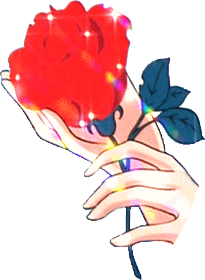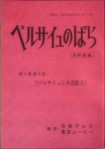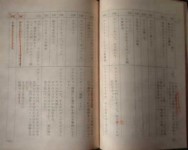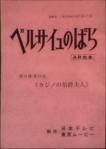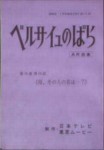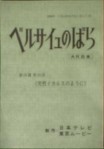
|
||||||||||||||||||||||
|
||||||||||||||||||||||
 The animation series who came after the original "Berusaiyu No Bara" manga-comics, internationally known as "Lady Oscar", it has been released many years after the first edition of comics: comics appeared in Japan in 1972 but fans had to wait until 1979, in order to see Oscar into animation. Riyoko Ikeda herself was the main reason of this delay: she was scared... maybe producers could upset her original work, maybe a bad interpretation on tv could also mark the fame of her comics. Who can say?
Selecting teams of animators involved producers since February to May 1979.
Next step was about the director: the direction of the LADY OSCAR tv-series was stormy. Producers would like to get Osamu Dezaki since the beginning but he declined and choice falled on Tadao Nagahama: they both had had great success in previous works... still none of them was skilled about "shoujo" genre since they were coming from series about robots... and Nagahama too he was in doubt about accepting. At first he was not concerned in working to such project but the possibility of a cooperation with Shingo Araki was great! So they told Tadao Nagahama finally read the Berubara manga comics in one night, then he entered TMS studos with great inspiration... Berubara deepest fans now know that his contribution to the project was all but lucky! (Photo: Tadao Nagahama)
Althought so many attentions (dubbers too had been choosen among most famous japanese voices of the years...), THE ROSE OF VERSAILLES was born under unlucky star! Audiences were low since the very beginning and gradually went down and down with running of episodes. More then this, animators times were too long: financers were expecting a prompt release and finally NTV couldn't wait more: they decided to transmit "LADY OSCAR" on tv even if the series had not been completed yet. Episodes started and ran on tv while the production was still on going: animators were not getting time to check drafts, drawings had to be mounted in a few days... and many errors appeared clearly to the public (above all in colouring figures). It was a pity... fabulous premonitions and such a disgrace.
Audience falled to zero in many zones of Japan.
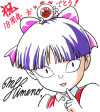  Osamu Dezaki
was also very well impressed with the work of Michi Himeno. Michi
Himeno is now mentioned everywhere about the making of THE ROSE OF
VERSAILLES animated seres (and not only, of course) but her role, at
the beginning of the project, had not to be so deep in this series.
It was Osamu Dezaki who guessed the talent of this artist and
decided to enlarge her partecipation to the series development.
Starting from episode 18, something happened: rithm changes and
focalizes the interior storms of the characters rather then
historical facts. Osamu Dezaki
was also very well impressed with the work of Michi Himeno. Michi
Himeno is now mentioned everywhere about the making of THE ROSE OF
VERSAILLES animated seres (and not only, of course) but her role, at
the beginning of the project, had not to be so deep in this series.
It was Osamu Dezaki who guessed the talent of this artist and
decided to enlarge her partecipation to the series development.
Starting from episode 18, something happened: rithm changes and
focalizes the interior storms of the characters rather then
historical facts. Dezaki's contribution was very important: he got staff to be more self-confident even because he had been a designer in the young period so he was able to work in strict connection with the Araki's team.(Photos: Michi Himeno) If you don't know, Michi Himeno is the author of the best Oscar's portraits that we can see during the animated series: first of all that marvellous table of Oscar, the one the opening starts with, where Oscar is surrounded by thorns (the same i am using for the graphic of this page); it is a proper subject of Michi Himeno. This image impressed the public very much in 1979, due to the fact that Oscar was naked... as well as another famous Himeno's table, the one where Oscar and Andrè are embraced into the grove and long hairs of Oscar are covering her backside: into the first drafts of this table, it seems that Oscar's hairs were not so long... it seems that Himeno had to lengthen them because some people told her that it was not convenient to show the backside of a peeress! :-) So if you have loved THE ROSE OF VERSAILLES animation, you shouldn't ever forget the name of Michi Himeno. Anyway, even if Dezaki entered the direction of the series, success of THE ROSE OF VERSAILLES was already marked: the first transmission had to remain a flop. Changes done to the original comics in order to make the story suitable for tv, they haven't been appreciated. In some parts of Japan, so a low audience convinced producers to stop the transmission of the series at the 23rd episode, after that they trasmitted a montage, entitled "Versailles no Bara: Moetsukita Bara no Shozo" (The Rose of Versailles: Portraits of burnt roses), who was resuming the end at one sight. The series was transmitted for the full length in the Tokyo district and at the end of the regular trasmission, NTV also presented an additional episode, lasting double then regular and quite unknown outside Japan, whose title was "EPISODE 41 - Versailles no Bara to Onnatachi" ("The Rose of Versailles and Women"). It was Wednesday, 10th September 1980. Japan flop was a fact but it didn't block producers when exporting the animation to Europe: in 1980 in Europe, THE ROSE OF VERSAILLES manga comics was not known so the european public was approaching to the vision without any preconception. The european public will simply face the series by Araki and its team and they will love Oscar as she could be into the anime, rathen then going on comparing these scenes with comics. It will be a great success! LADY OSCAR animation had a great success in Europe during '80s and, in the meanwhile, Shingo Araki and Michi Himeno had new occasions to demonstrate their talent in Japan; following the greatest success of Saint Seiya (signed by Araki and Himeno), japanese critics slowly got ready to reconsider THE ROSE OF VERSAILLES anime screenplay... and the LADY OSCAR animation started to be more appreciated in the native country too. As about my knowledge, THE ROSE OF VERSAILLES animated series has been dubbed in these languages: Italian, French, German, Catalan, Portoguese, Finnish, Chinese, Mandarin Chinese, Korean, Arab. I actually own versions of the anime in all these languages but Portoguese and Finnish... so if any of you should actually own the series in such languages, please contact me: it will be greatly appreciated. Let's conclude and tell that LADY OSCAR ANIME is something different from BERUSAIYU NO BARA MANGA: the anime screenplay turns around two people, Oscar and Andrè and their Revolution is an inner experience more then a historical fact. The series presents the drama of two souls shaked by tragical destiny... the historical period in which the story takes place is not so important... it is something like the narrator's voice who marks the scenes day by day, while Oscar and Andrè love will go on forever... |
||||||||||||||||||||||
|
||||||||||||||||||||||
|
The exact translation of BERUSAIYU NO BARA (manga by Riyoko Ikeda) in English is "The Rose of Versailles" and, in the mind of the Author, for sure it was the metaphor to signify Marie-Antoinette (...); the animation series came out in Japan with the same title but it was exported in Europe as "LADY OSCAR": so i think it should be interesting to investigate the reason of this change. First of all i must inform you that the titles of exported productions (japanese animation productions, i mean) are usually assigned by exporters: "LADY OSCAR" had been choosen to be the title of the animation in Europe and this choice came from Japan, it was not an European decision. Main reason of this title was the fact that the most interesting character of the story, as into the mind of the japanese public, she was Oscar rather then Marie-Antoniette... Oscar had been able to attract the attention of readers much more then the queen... so that also Jacques Demi's Live Movie was conceived to narrate the Oscar's life, far from beeing a project for a new Marie-Antoinettès biography. Also the anime, just like the movie, had been produced minding to
commercial purposes so it was almost important to accomplish the
public: people wanted to see Oscar becoming the main star of the
story and producers decided to face this wish. They needed a
significative title who could impress people at first look,
so they thought to "LADY OSCAR", using feminine term "Lady"
just before a men's name, "OSCAR"! And they really captured!! Anyway, if you try to search anything about LADY OSCAR into japanese search engines, you won't easily find anything because the japanese title could not be changed: the trademark of the series was THE ROSE OF VERSAILLES and this was! The title changed for importers only. In Japan, the original title actually remains "THE ROSE OF VERSAILLES" for both comics and animation but after the animation production, the use circulated to translate the title as singular when referring to comics ("THE ROSE OF VERSAILLES" or "LA ROSE DE VERSAILLES"), while plural when referring to animation ("THE ROSES OF VERSAILLES" or "LES ROSES DE VERSAILLES"). Such difference is clearly viewable into some official editions of the anime, even if rarely people note it. But there are many examples. Really, if translating title as plural, we can signify the screenplay of the animation at best and also the animation symbolism: in facts it's true that the anime presents Marie-Antoinette as the first character who appears among roses... still, starting from episode 4th, Oscar too often appears together with roses... and the most beautiful portraits of Oscar during the series will show her among these flowers... (look at the pictures below)
This is about the animation only: please don't mistake comics with animation! Recently we have assisted to a proper "title affair" as if the translation of the title, as about Riyoko Ikeda mindings, was not clear!! Riyoko Ikeda ment to dedicate her masterpiece to Marie-Antoniette and there are not doubts about this fact. I have explained the reasons widely into the page of the manga. Any other interpretation of the title has came out with the passing of years and mainly with the release of the animated series, for the reasons above. But - i repeat - no doubts about the fact that THE ROSE OF VERSAILLES was born as metaphor for the Queen of France. And if you actually ask Mrs. Ikeda about the main star of the story, she will answer MARIE! Comics dedicated to Marie-Antoniette introduced Oscar to us... we loved her; Animation came out with one dedic only: OSCAR FRANCOIS DE JARJAYES, the rose of Andrè... In order not to create a deep fraction between meanings of comics and animation, the use diffused in Japan to refer to Marie-Antoinette as to the RED ROSE and to OSCAR as to the WHITE ROSE, also recalling the wonderful monologue of Andrè during unforgettable episode 28th. Actually Mrs. Ikeda also used this dualism into some of her works. |
||||||||||||||||||||||
|
|
||||||||||||||||||||||
Anime Scripts |
||||||||||||||||||||||
|
||||||||||||||||||||||
|
Let's show something cute about the animation production: these little booklets are the "anime scripts" with the original dialogues of the series, as they have been shared among the dubbers and animators when mounting the episodes. They actually got a very high collectors value. |
||||||||||||||||||||||
|
Music added as background in this page is a piece cut and resampled from the "Uruwashiki hito yo" piece by Kouji Makaino. Please note it's here to publicize the original soundtrack. Any kind of reproduction is not allowed. This website exists for collectors of original material only, we don't promote and we don't support diffusion of illegal materials ever. We do all, with regards to original creators and authors. |









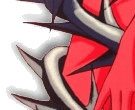
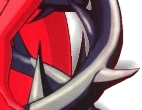












 Funds
granted to this series were high as never for any animation project:
the original manga was so famous in Japan that none had doubts about
mad investments. Producers could not risk: they decided and offered
the project to ARAKI PRODUCTION. Shingo Araki was mostly appreciated
at that time, thanks to his work at Ufo Robot Grendizer and he was
favourite among designers because he was used to keep deep attention
to the look of the characters... he had got thousands teens fallen
in love with Actarus... Beauty has to be very important in LADY
OSCAR's characters design: Riyoko Ikeda figures were wonderful and
Shiseido was producing cosmetics... Oscar had to be fascinating!
(Photo: Shingo Araki)
Funds
granted to this series were high as never for any animation project:
the original manga was so famous in Japan that none had doubts about
mad investments. Producers could not risk: they decided and offered
the project to ARAKI PRODUCTION. Shingo Araki was mostly appreciated
at that time, thanks to his work at Ufo Robot Grendizer and he was
favourite among designers because he was used to keep deep attention
to the look of the characters... he had got thousands teens fallen
in love with Actarus... Beauty has to be very important in LADY
OSCAR's characters design: Riyoko Ikeda figures were wonderful and
Shiseido was producing cosmetics... Oscar had to be fascinating!
(Photo: Shingo Araki)

 Producers
failed the direction but they didn't about musics! The LADY OSCAR's
animation soundtrack was committed to a young musician (31 years),
his name: Kouji Makaino. And he did the best soundtrack ever made
for an animated series. After THE ROSE OF VERSAILLES animation
soundtrack, Makaino entered a bright career, he signed hundreds
famous soundtracks and he is now working for cinema too. Of course
we can't forget to mention also the wonderful voice of Mrs. Hiroko Suzuki,
main singer of the Berubara soundtrack's songs. (Photos:
Kouji Makaino and Hiroko Suzuki)
Producers
failed the direction but they didn't about musics! The LADY OSCAR's
animation soundtrack was committed to a young musician (31 years),
his name: Kouji Makaino. And he did the best soundtrack ever made
for an animated series. After THE ROSE OF VERSAILLES animation
soundtrack, Makaino entered a bright career, he signed hundreds
famous soundtracks and he is now working for cinema too. Of course
we can't forget to mention also the wonderful voice of Mrs. Hiroko Suzuki,
main singer of the Berubara soundtrack's songs. (Photos:
Kouji Makaino and Hiroko Suzuki) After
the first 10 episodes, producers maybe thought it was a grace if the
series was not yet drawn... because it could be changed while
developing! For first, they thought they had to convince Osamu
Dezaki who could take the direction. Osamu
Dezaki officially entered the staff on the 18th episode even if,
practically, he had started to embody the director's role since the
12nd episode: in facts Nagahama felt disfavour around himself soon,
while sensing the meeting of minds between Dezaki and Araki, who had
already started to work together. (In foto, Osamu Dezaki).
After
the first 10 episodes, producers maybe thought it was a grace if the
series was not yet drawn... because it could be changed while
developing! For first, they thought they had to convince Osamu
Dezaki who could take the direction. Osamu
Dezaki officially entered the staff on the 18th episode even if,
practically, he had started to embody the director's role since the
12nd episode: in facts Nagahama felt disfavour around himself soon,
while sensing the meeting of minds between Dezaki and Araki, who had
already started to work together. (In foto, Osamu Dezaki).

